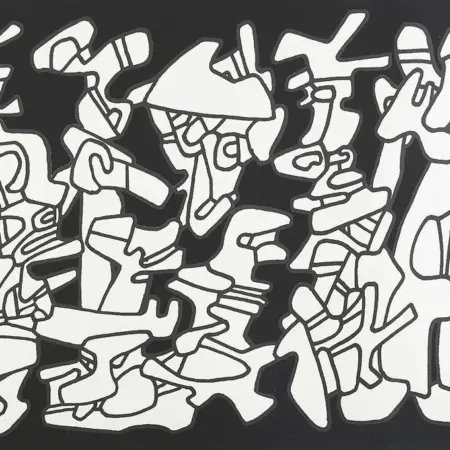
Jean Dubuffet (1901-1985). Felt tip pen drawing on paper titled “Le Verre d’Eau III.” Initialed and dated 1966 along the lower right. Inscribed “M 250 17/11 3” and “Le Monde Gallery” along the verso.
Provenance: Galerie Beyeler, Basel; Le Monde Gallery, New York, New York; Private collection, Minnesota
Literature: “Catalogue des Travaux de Jean Dubuffet,” fascicule XXII, no. 192, p. 67.
Lot Essay: Jean Dubuffet was one of the most consistently innovative artists of the 20th century. His constant desire to push the boundaries of what was understood as beauty and art led to a widely varied and often provocative oeuvre. Dubuffet was born into a family of successful wine merchants in Le Havre, France. After a stint of painting in Paris, during which he briefly attended the Academie Julian and became friends with Fernand Leger, Juan Gris, and Raoul Dufy, he gave up on art. He served in the army for a short while, then settled down to sell wine and start a family, living an affluent suburban life. However, he found himself unsatisfied with his life, and in the early 1940s, he made a return to painting for good. Dubuffet found early success with his paintings of the people around him in the streets of Paris, but continued to shift and experiment throughout his career, moving sequentially through various discrete cycles and styles.
Dubuffet was strongly opposed to the mainstream art establishment, describing himself as anticultural, and strove to move away from standard definitions of beauty and quality in his art. He founded the Art Brut movement, championing outsider art and untrained artists, and incorporating some of the rough elements of these artists work into his own style. He also rejected the traditional art establishment through his continuous experimentation with textures and media, using materials as unorthodox as gravel, tapioca, glass, tar, and fruit to create visceral and tactile compositions.
Dubuffet found the inspiration for his Hourloupe cycle, which consumed his attention for much of his later career, while talking on the telephone. Doodling on his message pad, he found himself enthralled by the smooth, continuous lines of his ballpoint pen. He soon began to experiment with what he could do with lines of this sort, creating mesmerizing compositions in the colors of pens: red, blue, and black. The lines enfold and encircle themselves, bending in hypnotic, amoebic squiggles. The works in this series range from representational to entirely abstract. They include works in a wide variety of media, moving far past the original pen and paper and eventually evolving into the Practicables series of sculptures.
Dubuffet’s Verre díEau series was executed in the midst of the Hourloupe cycle. Literally translating to glass of water, the Verre díEau drawings utilize the artistic vocabulary of the Hourloupe cycle to create a tongue-in-cheek take on still life, depicting glasses of water with the sort of distortions a viewer would expect when looking through a glass of water. The forms walk the line between representational and abstract, providing a graphic representation of how Dubuffet felt the object looked in the mind, something he strove for in his Hourloupe works.
This drawing, Verre díEau III, is a striking example of work from the Verre díEau series. The gentle colors and parallel blue lines evoke the notebook paper that initially inspired the Hourloupe cycle, suggesting a casual doodle, although this is clearly a careful and precise piece of work. Despite this simplicity in form and subject matter, the silhouette bears a striking and unmistakable resemblance to the iconic ancient Egyptian bust of Nefertiti, creating a regal overtone to the work. It is up to the viewer to sort through layers of meaning, attributions of loftiness and lowliness, contained in this drawing. It is part of the honored tradition of still life, but on such a pedestrian subject as a glass of water. Deceptively simple, this bold and striking image illustrates Dubuffet’s philosophies about celebrating beauty in mundane and unexpected spaces. He wrote, Look at what lies at your feet! A crack in the ground, sparkling gravel, a tuft of grass, some crushed debris offer equally worthy subjects for your applause and admiration. Why not, then, a glass of water or doodles on a telephone message pad?
Height: 19 in x Width: 9 3/4 in.
$26,000

